 3M Club Chess Club Newsletter
3M Club Chess Club Newsletter  3M Club Chess Club Newsletter
3M Club Chess Club Newsletter
Editors: Ken Goebel, Steve McRoberts Vol. 1, No. 4
_______________________________________________________________________
Meet the Players: Bob Siegel

Bob Siegel has been with the 3M Club Chess Club for about the past seven years (though he played for 3M in the Twin Cities Chess League years before). He played chess a little as a boy, but didn't start playing seriously until 1972, spurred on by the Fischer - Spassky world championship match. However, Bob is quick to note that he is not fond of Bobby Fischer, and considers him an "embarrassment" to the chess community. Bob feels so strongly about this, in fact, that he sent a letter on the subject to Chess Life, which was published a few years ago.
The best thing Bob likes about chess is the variety. "Every game is different," he says. While no particular player has influenced him, he enjoys the games of the old masters such as Frank Marshall and Akiba Rubinstein. His advice to aspiring players is to read chess books and magazines, and to go over the games of such masters.
If there was one thing Bob would change about chess it is its popularity. "I find it hard to believe," he says, "that in a company this size, we have so few members in the Chess Club."
Bob has worked for 3M for 22 years, and currently works at the Cottage Grove plant, ensuring environmental compliance of the corporate incinerator. In the summer, you can find him on the tennis courts (playing for the 3M Club Tennis Club, naturally).
Novice Corner: The Importance of the Opposition in the Endgame
By Chuck Nelson
In a recent game against Larry Boardman I played pretty well, well enough at least to make it to a King and pawn endgame. With about a minute left on each clock, we ended up in the following position with it my (white) turn to move:
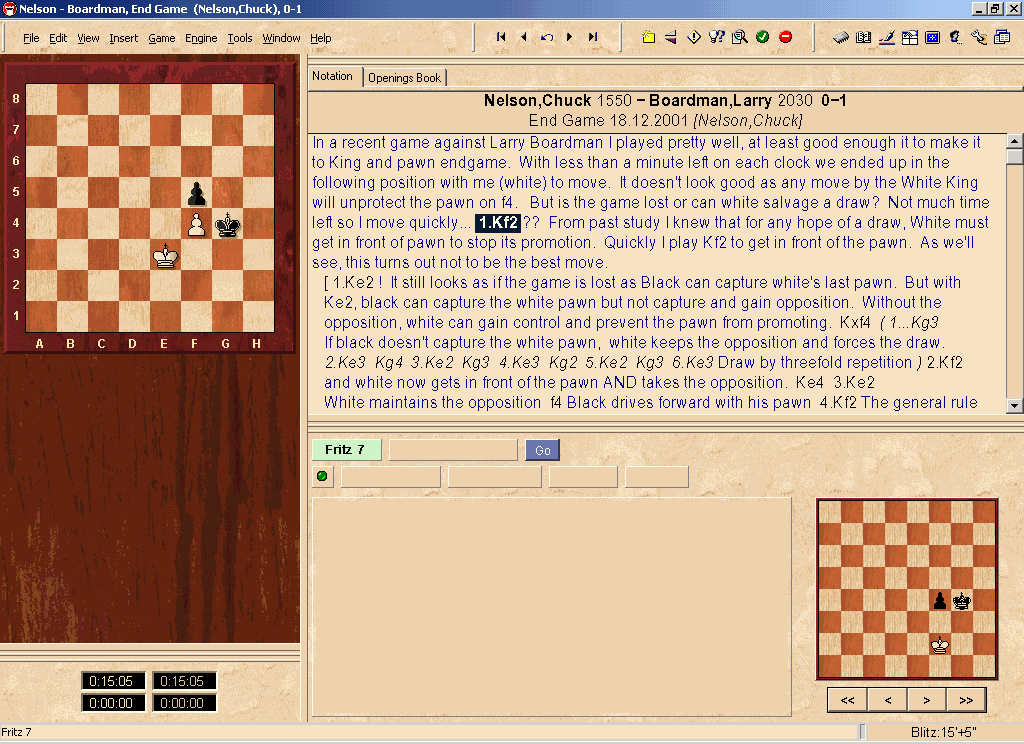
Nelson vs. Boardman
Figure 1: White to Move
It doesn't look good as the white pawn can't move and any move by the White King will unprotect the pawn on f4. Is the game lost or can white still salvage a draw? There's not much time left and from past study I knew that for any hope of a draw, I must get in front of the pawn to stop its promotion. Quickly I play 1. Kf2?? to get in front of the pawn. As we'll see, this turns out not to be the best move. Black counters with 1...Kxf4
Not only does black capture the unprotected pawn, more importantly he captures "the opposition" What is opposition? It is an important concept that enables the person who has it to force the other king around, in essence, to become stronger than the other king. To get the opposition, on any rank, file, or diagonal, you maintain an odd number of squares between the kings. The move 1...Kxf4 does just this (see figure 2).

Fig 2: Black takes the opposition
Black keeps an odd number of squares (one) between the kings. As the next moves illustrate, with the opposition black is able to force the white king away from the promotion square and win the game. 2. Kg2 Ke3 Here black seems to give up the opposition but his pawn is now free to move and black can grab back the opposition if he needs it. In general, the rule is to move the king forward as far as possible until the pawn is in danger. 3. Kg3 f4+ 4.Kg2 Ke2. At this point, the game is won. This is why you want to push the king as far forward as possible. When the black king reaches e2, it controls the promotion square f1 and white cannot recapture the pawn or block its path because the black king controls f1, f2, and f3. At this point even though black has only thirty seconds left, it's academic for Speed Champ Larry. He quickly dispatches me with: 5. Kg1 f3 6. Kh1 f2 7. Kg2 f1Q+ 8.Kh2 Qf3 9. Kg1 Qg4+ 10. Kh2 Kf3 11. Kh1 Qg2++
But was there still an opportunity for me if I had controlled the opposition? The variation on the next page illustrates that indeed all was not totally lost.
An Alternate Ending
: So what if instead of immediately getting in front of the pawn, white just drops back? 1.Ke2!?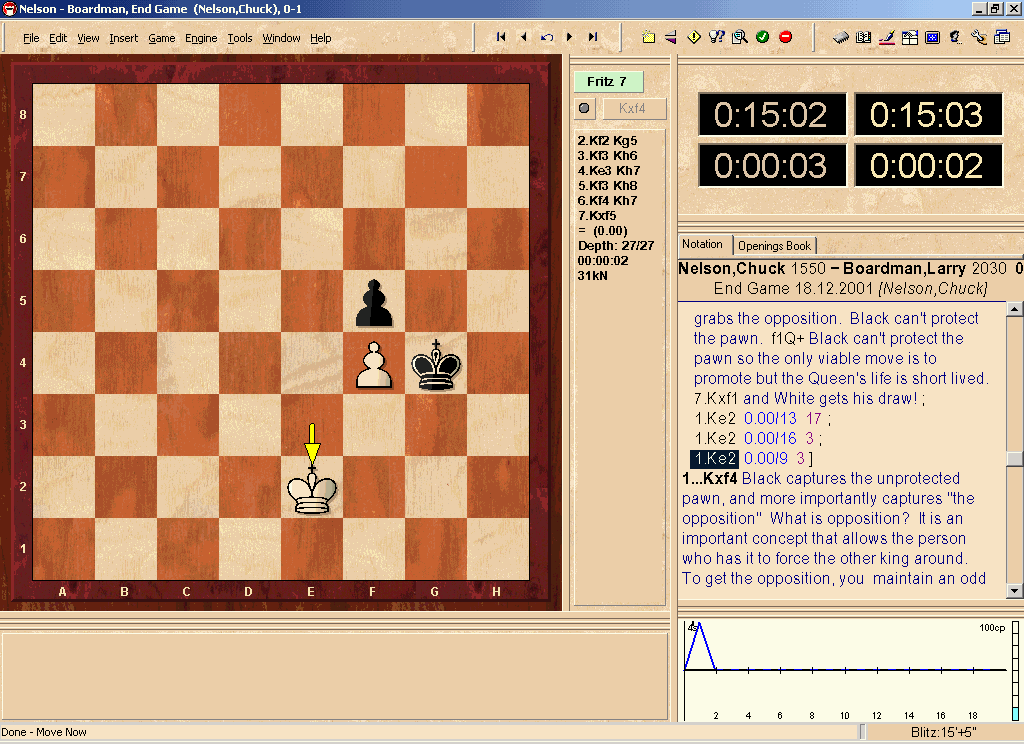
Fig 3: White drops back
It still looks as if the game is lost as Black can capture white's last pawn. But with 1.Ke2, black can capture the white pawn but not capture and gain opposition. Without the opposition, white can gain control and prevent the pawn from promoting. After 1...Kxf4 white now gets in front of the pawn AND takes the opposition with 2.Kf2.
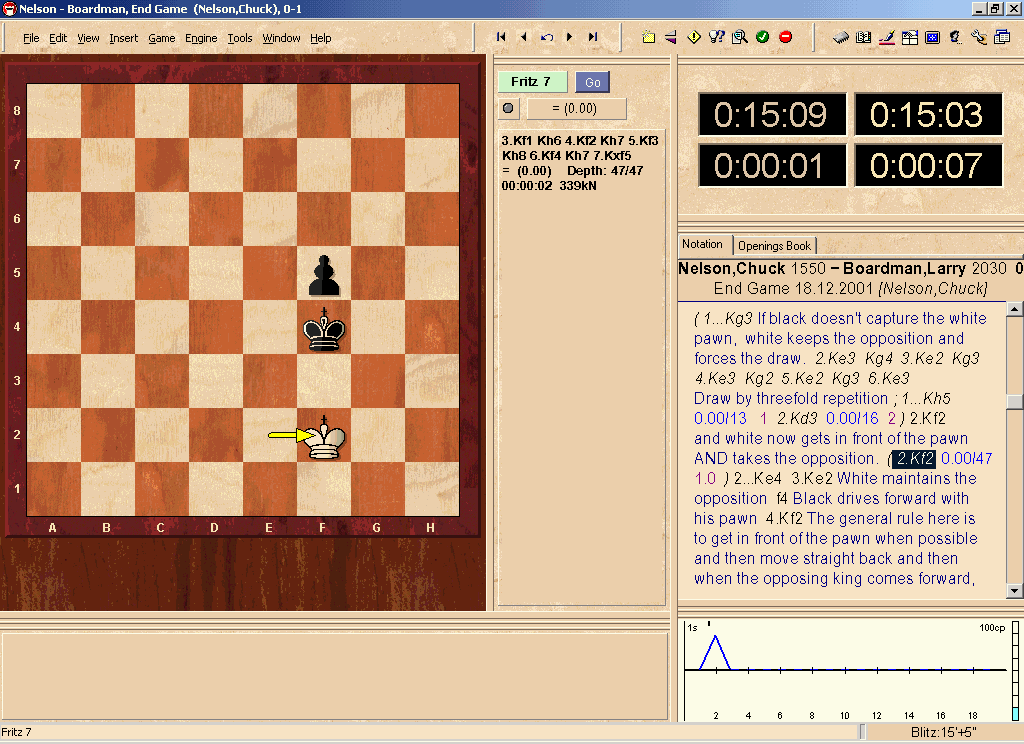
Fig 4: White takes the opposition
With 2...Ke4 3.Ke2 White maintains the opposition 3...f4 Black drives forward with his pawn 4. Kf2 The general rule here is to get in front of the pawn when possible and then move straight back. When the opposing king comes forward, take back the opposition. 4...f3 5.Kf1 Per the rule of thumb, white moves straight back. Black advances his King to protect the pawn 5...Ke3 and white is forced to move out of the way but this time grabs the opposition as he does so with 6.Ke1!
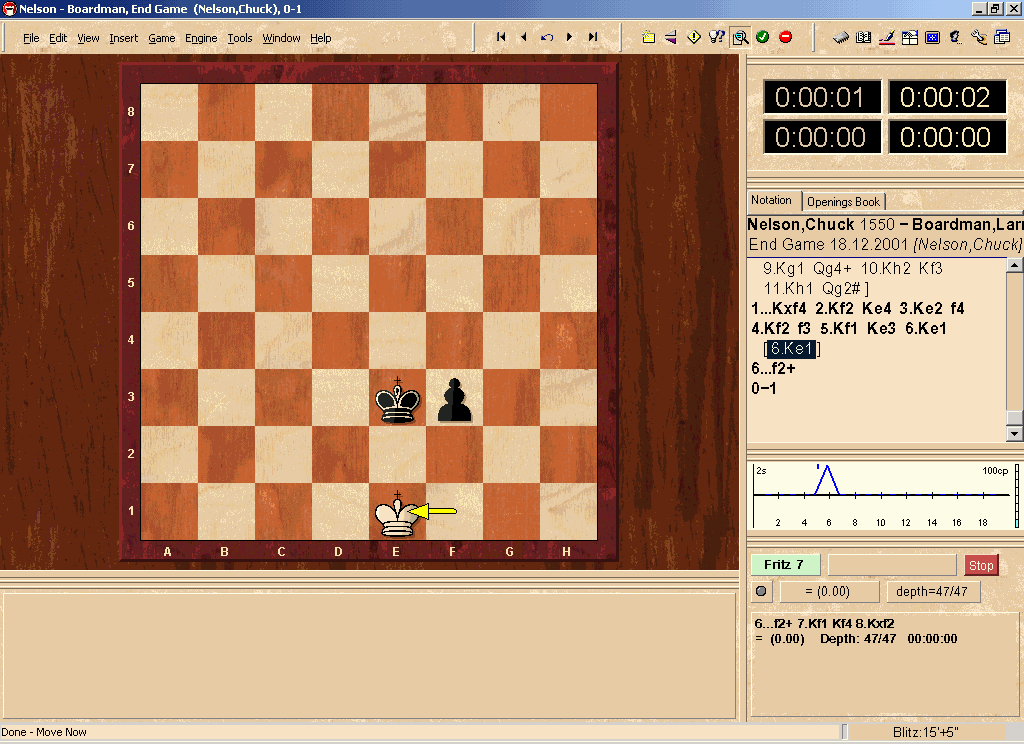
Fig 5: White maintains the opposition
6...f2+ 7.Kf1. and it's a draw because either the pawn falls or it is stalemate.
As a final alternative, assume that black doesn't capture the white pawn, but rather plays 1...Kh3. White can still keep the opposition and force the draw: 2.Kf3 Kh4 3. Ke3 Kg3 4. Ke2 Kxf4 5. Kf2 and we're back in the position shown in figure 2.
Along with basic opposition, the concepts of rectangular opposition, triangulation, and outflanking are also important in the end game. These concepts are covered nicely in the "Chess Mentor" training software. You can find demos of Chess Mentor on the Internet at
www.chess.com or www.chessusa.com. I strongly recommend you check it out!Games From 3M Chess League With Middlegame Tactical Themes
The Games
The following game contains the tactical themes "Double Attack" and "Pinning"
3/12/2002 (League Tournament 2, Round 5)
ECO E91: King's Indian Defence
Result 1/2-1/2
1. Nf3 Nf6 2. c4 g6 3. Nc3 Bg7 4. d4 d6 5. e4
{ This straightforward development leads to long and involved systems of attack and defence, where opening theory is discussed as deeply as move 20 to 30. }
5... O-O 6. Be2 Nc6 7. h3
{ This is less often played than A: 7.O-O e5 8.d5 Ne7 9.Ne1 Ne8 10.Nd3 f5 11.Bd2 Nf6 12.exf5 Nxf5 13.Re1 +0.04 Or B: 7.d5 Nb8 8.O-O e5 9.Bg5 h6 10.Bh4 g5 11.Bg3 Nh5 12.Nd2 Nf4 13.Bg4 Nd7 14.b4 +0.35 }
7... e5 8.d5 Ne7 9.O-O Ne8 10. Bg5
{ End of Book. ECO E91. King's Indian Defence. Score +0.27 }
10... f5 11. exf5 gxf5 12. Qd2 Nf6 13. Bh6 f4 14. Bxg7 Kxg7 15. Bd3 Bf5?!
{ [ Allowing White to threaten a powerful triple fork (!) on e6 with his knight, as in the game. ] Score -1.36. CENTURY 15...Kg8 16.Ne4 Nxe4 17.Bxe4 a5 18.Rae1 Nf5 19.Bc2 Bd7 20.c5 -0.28 }
16. Bxf5 Nxf5 17. Ng5 Nd4?!
{ Score -3.00. CENTURY 17...Re8 18.Ne6+ Rxe6 19.dxe6 Nd4 20.Qd3 Nxe6 21.Rfe1 Nd4 -1.18 }
18. Ne2?!
{ Score +1.79 CENTURY 18.Nb5 Kg8 19.Nxd4 exd4 20.Ne6 Qe7 21.Nxf8 Rxf8 22.Rae1 Qg7 +3.01}
18... Nxe2+ 19. Qxe2 Re8 20. Ne6+
{ The knight fork, winning the exchange. An example of the theme 'Double Attack'. }
20... Rxe6 21. dxe6 Qe7 22. Qf3 Qxe6 23. Qxb7 Rg8 24. Qf3
{ Watching over the safety of the king's home. White doesn't fear losing his c4 pawn, as he can win it back with Rc1 and Rxc7, and at the same time posting his rook on the 7th rank, where it is in a much better attacking position! }
24... Kh8 25. Kh2
{ Making room for a defender rook on g1 }
25... Qxc4 26. Rfc1 Qf7 27. Rc6 e4
{ This allows a second thematic maneuver for white - a pin of the knight on f6, taking some of the wind out of black's attacking chances on the k-side! }
28. Qc3
{ Pinning with the queen (!), while at the same time threatening Rxc7. }
28... Qg6 29. Rg1 e3 30. fxe3 Qg3+ 31. Kh1 Rg6 32.exf4 Qxf4 33. Qf3
{ White relinquishes the pin on f6 to trade down into a favorable endgame. The pin has served its purpose! } 33... Qe5 34. Rxc7 Ne4 35. Rc8+ Rg8
{ Kg7 loses to 36.Qf8 mate! }
36. Rxg8+ Kxg8 37. g4
{ Now white has a won endgame with 38.Rg2. }
37... d5 38. Kg2?
{ Score +0.77. What?? White moves the wrong piece, giving Black a cheap draw! White shook his head for 10 minutes, looking for a way to salvage this blunder. CENTURY 38.Rg2 +2.73 }
38... Qxb2+ 39. Kh1 Nf2+
{Black offered a draw, which White accepted. The game might have continued 40.Kg2 (or Kh2) Nxg4+ 41.Kg3 ( if 41.Kh1?? Qh2 mate ) Qh2+ 42.Kh4 Qxg1 43.Qxd5+ draw } 1/2-1/2
Game 2
The following game contains the tactical theme "X-ray Attack"
03/05/2002 (League Tournament 2, Round 4)
ECO D20: Queen's Gambit Accepted
Result 1-0
1. c4 d5 2. d4 dxc4
{ The Queen's Gambit Accepted. Many top players have it in their repertoire, including Nigel Short, Anatoly Karpov and Yasser Seirawan. Fischer used it to draw at will with Spaasky in their 1992 match. }
3. e4
{ This has been very popular in master play during the early 1990's. Theory is not yet certain. }
3... e6 4. Bxc4 c5
{ Better is 4...Nf6 5.Nc3 Bb4 6.f3 Nc6 7.Nge2 O-O 8.Be3 e5 -0.33. }
5. d5
{ Korchnoi's move. Sets the strategy of the game, which centers around attack and defence of the point d5, and in this game eventually leads to a thematic 'X-ray Attack' for White! }
5... Nf6 6. Nc3 a6 7. a4 Be7 8. Bf4
{ Theoretical deviation (TD). Out of book. ECO D20. Queen's Gambit Accepted. Score -0.73. Opening continuation is 8.Nf3 O-O 9.O-O exd5 10.exd5 Bg4 11.h3 Bxf3 12.Qxf3 Nbd7 13.Bf4 Nb6 14.b3 +0.57 }
8... exd5 9. Nxd5 Nxd5 10. Bxd5 O-O 11. Ne2 Nd7 12. O-O Nf6 13. Nc3 Nxd5 14. Nxd5 Be6?!
{ Giving White the opportunity to launch an X-ray Attack with the moves 15.Nxe7 and 16.Bd6, winning the exchange. Score -1.55. CENTURY 14...Bd6 15.e5 Bc7 16.e6 Bxf4 17.e7 Bxh2 18.Kh1 Qd6 19.exf8 -0.45 }
15. Nxe7+ Qxe7 16. Bd6 Qg5
{ Moving either rook to d8 to pin the bishop doesn't work. Black then loses a rook with 17.Bxe7, instead of the exchange. }
17. Bxf8 Bh3?
{ Loses a rook outright. Score -4.43 CENTURY 17...Rxf8 18.Qd6 Rd8 19.Qc7 Bh3 20.Qg3 Qxg3 -1.98. }
18. Qf3 Bxg2 19. Qxg2 Qxg2+ 20. Kxg2 Kxf8 21. Rfd1 Ke7 22. Rd5
{ With the idea to restrict Black's king to the back ranks, rather than attacking the c-pawn. }
22... b6 23. Rad1 Ra7 24. Rd6
{ Further restricting Black's king }
24... b5 25. a5 c4 26. Rb6
{ The plan is to double the rooks on the 6th rank, limiting the movement of the Black king, and winning the a-pawn. The rooks have a crushing grip on Black's position. Black feels the crush, and resigns. } 1-0
Speed Chess Tournament Results
Final standings:
1ststplace Duane Hart 65%
2nd place Bob Siegel 60%
3rd place Ken Goebel 57%
Congratulations to Duane, and thanks to all who played in this year's speed tournament!
Final Tournament of the Season Begins April 2nd!
Those who have played in one or both of our league tournaments this season are eligible to play in our final tournament of the season. A round will be played every Tuesday evening except for the last Tuesday in April. The tournament ends April, 23rd. This will be every person for themselves (no teams). Please let me (Steve) know whether or not you will be playing ASAP! At the same time, let me know if you'd be interested in attending summer chess. I am not planning on holding summer chess this year unless several people commit to attending.
Sharpen Your Tactical & Endgame Skills With BOOKUP
By Ken Goebel
There is very good chess teaching software available, which allows one to study and practice a variety of chess themes, such as openings, master games collections, middlegame tactics, and endgame strategy. The software I like the most, and which I think is the most versatile at this, is BOOKUP, which was programmed by Mike Leahy, and can be obtained at his internet website
http://www.bookup.com/home.html (and click on "Windows Catalog")
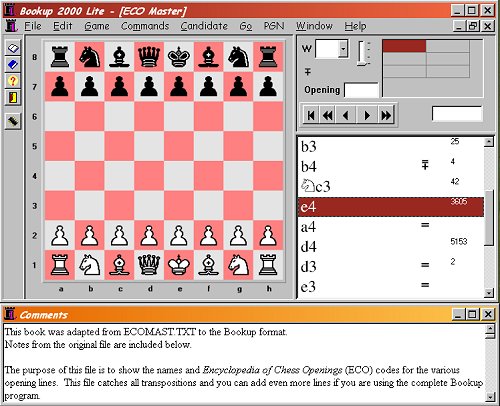 Several versions are available, including Bookup Lite (16-bit version) which is free!, and Bookup 2000 Lite (32-bit version) for $5! I've ordered an evaluation CD's of Bookup 2000 Lite for the 3M chess club library. This runs under Windows 32-bit operating systems. A picture of Bookup 2000 Lite is shown above, with the opening book "Encyclopedia of Chess Openings (ECO)" in view:
Several versions are available, including Bookup Lite (16-bit version) which is free!, and Bookup 2000 Lite (32-bit version) for $5! I've ordered an evaluation CD's of Bookup 2000 Lite for the 3M chess club library. This runs under Windows 32-bit operating systems. A picture of Bookup 2000 Lite is shown above, with the opening book "Encyclopedia of Chess Openings (ECO)" in view:
In the picture, the lower right window displays all the first move "candidates" frequently played in tournaments. The bottom window displays comments for a given move, such as the ECO opening code, and perhaps some information about the position. You click on a candidate to make the move in the chess diagram. Bookup 2000 Lite also comes installed with a chess analysis engine, Crafty version 17.9, which is of high master playing strength (2400 rating). So one may also use any Bookup 2000 (including Lite, Express, and Professional versions) to analyse the best move of a position by using Crafty. This feature is not available in the 16-bit version, Bookup Lite!
The main reason I'm writing this article is not to publicize BOOKUP to the chess club, but rather to describe some projects I'm working on that use Bookup 2000 as a teaching/training tool, and for practice in sharpening chess playing skills in the opening, middlegame, and endgame phases. These projects are files that can be loaded into Bookup, and will be posted on our 3M Chess Club website for downloading, as I get various stages of the projects completed.
Opening Phase
My first project involves expanding on the ECO book that already comes in Bookup 2000 Lite, so that every candidate move will be linked to an ECO opening code, and every opening line linked to an Informant rate symbol (i.e., = for "equal position", +/- for "white is better", =/+ for "black is slightly better", etc.). The Informant rate symbols are assigned auotmatically by Crafty when it is used to analyse a position. This project is nearly completed, and the ECO book will be available on the club's website to download. This compressed ECO file will expand into the "opening book" files used by Bookup 2000. Just load the expanded files into the Bookup directory on your computer's hard drive, and open it as a book. There are about 8600 different ECO opening variations or lines covered in this book! This ECO file will not work in the Bookup Lite (16-bit) version.
Middlegame Phase
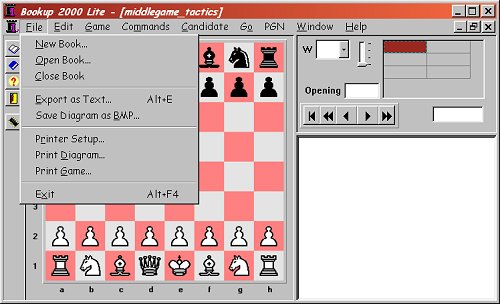 This project is going on simultaneously with the opening book project. This is a series of middlegame tactical themes in pgn file format, which can be downloaded also from the club's website. These pgn files can then be imported into Bookup 2000 lite (or the16-bit Bookup Lite), to create individual books for each tactical theme. Each tactical theme will have about 50 positions to solve, with a crucial first move to win material or the game. My source for the tactical exercises is the "Encyclopedia of Chess Middlegames", and includes about 1800 tactical exercises. The first half of the book is simple(!) winning combinations, and the latter half is more difficult exercises. So far, I have completed the simple themes, "Double Attack" (50 positions), "Discovered Attack" (53 positions), and "Pinning (47 positions). These will be available soon to download as compressed pgn files from the club's website. To install a theme into Bookup 2000 Lite, first create a new book as in the above diagram, by selecting "New Book". After naming the new book, i.e., "double attack", select the menu item "PGN", and import the "double_attack.pgn" file you downloaded from the club website. Do the same again to ceate a new book with the downloaded "discovered_attack.pgn" file. (To install a theme into 16-bit Bookup Lite, select the menu item "File" to import the downloaded pgn files.)
This project is going on simultaneously with the opening book project. This is a series of middlegame tactical themes in pgn file format, which can be downloaded also from the club's website. These pgn files can then be imported into Bookup 2000 lite (or the16-bit Bookup Lite), to create individual books for each tactical theme. Each tactical theme will have about 50 positions to solve, with a crucial first move to win material or the game. My source for the tactical exercises is the "Encyclopedia of Chess Middlegames", and includes about 1800 tactical exercises. The first half of the book is simple(!) winning combinations, and the latter half is more difficult exercises. So far, I have completed the simple themes, "Double Attack" (50 positions), "Discovered Attack" (53 positions), and "Pinning (47 positions). These will be available soon to download as compressed pgn files from the club's website. To install a theme into Bookup 2000 Lite, first create a new book as in the above diagram, by selecting "New Book". After naming the new book, i.e., "double attack", select the menu item "PGN", and import the "double_attack.pgn" file you downloaded from the club website. Do the same again to ceate a new book with the downloaded "discovered_attack.pgn" file. (To install a theme into 16-bit Bookup Lite, select the menu item "File" to import the downloaded pgn files.)
 Then use Bookup 2000 Lite to practice each position for a given theme. After you have the book opened, for example "double_attack" as in the picture above, select "Jump to Position" (With 16-bit Bookup Lite, select the menu item "Game" and then "Load...".)
Then use Bookup 2000 Lite to practice each position for a given theme. After you have the book opened, for example "double_attack" as in the picture above, select "Jump to Position" (With 16-bit Bookup Lite, select the menu item "Game" and then "Load...".)
This takes you to a list of all the available positions to study in the theme, each position being identified by the names of the players (as shown below). These are positions from actual tournament games by masters and grandmasters. Select any position and it will be uploaded into the Bookup position window. The solution to the winning combination will appear as a candidate move in the candidate window.
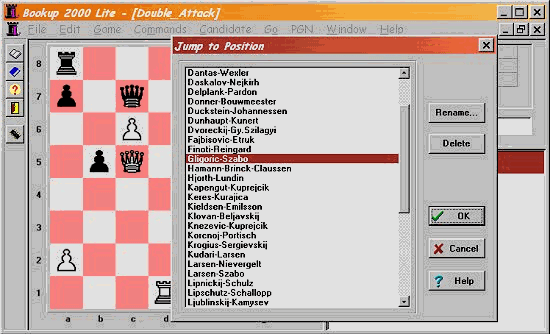 An example of Discovered Attack is shown in the following picture:
An example of Discovered Attack is shown in the following picture:
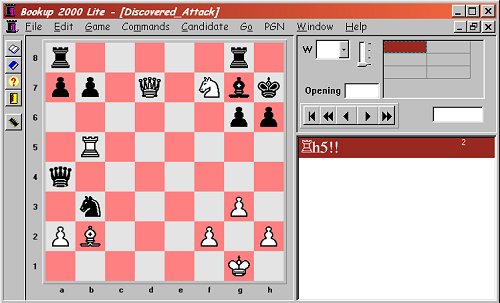
Here the winning move is 1.Rh5!! uncovering an attack by White on Black's queen, while at the same time threatening mate as follows: 1...Qxd7 2.Ng5+ Kh8 3.Rxh6#. If 1...Qa6 2.Rxh6+ Bxh6 3.Ng5#.
One can cover up the answers to the winning moves in each middlegame tactical lesson, by selecting "Training" mode from the "Command" menu
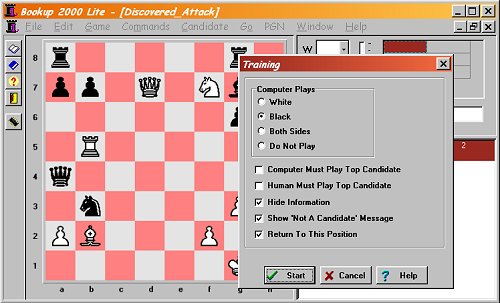 as seen in the picture above. Here the winning moves are covered up by Bookup after selecting the computer to play "Black" (and you are White then, since it is White to move and win), and selecting "Hide Information", and "Show Not A Candidate Message".
as seen in the picture above. Here the winning moves are covered up by Bookup after selecting the computer to play "Black" (and you are White then, since it is White to move and win), and selecting "Hide Information", and "Show Not A Candidate Message".
[Ed: In some lessons you are to play Black. Therefore, I find that checking "Do Not Play" works better. Then, an ellipsis in the upper-right window indicates Black to move. After your move, click the ">" button to make the computer move.]
 The computer will only allow you, as White, to play the moves of the winning combination, and will give you a message if you make the wrong move. Here I tried to make the move 1...Qe4 which is not a part of the winning combination, so the "Not a Candidate" window popped up. Notice also, that now the candidate moves are hidden, so you must guess the winning moves. Alternatively, one can play through the exercises without using "Training" mode, where the candidate moves are visible, and you can move through the winning combination by clicking on the candidate moves.
The computer will only allow you, as White, to play the moves of the winning combination, and will give you a message if you make the wrong move. Here I tried to make the move 1...Qe4 which is not a part of the winning combination, so the "Not a Candidate" window popped up. Notice also, that now the candidate moves are hidden, so you must guess the winning moves. Alternatively, one can play through the exercises without using "Training" mode, where the candidate moves are visible, and you can move through the winning combination by clicking on the candidate moves.
There are many middlegame combination themes covered in the book "Encyclopedia of Chess Middlegames", including:
Double Attack
Discovered Attack
Pinning
Deflection
Decoying
Interception
Annihilation of Defence
Space Clearance
Blockade
X-Ray Attack
Overloading of Pieces
Intermediate Move
Pawn Breakthrough
Passed Pawn
Demolition of Pawn Structure
Pursuit
So far, I've completed the simple exercises "Double Attack", "Discovered Attack", and "Pinning", about 150 positions out of 1800 or so in the book. These exercises will be available to download from our chessclub website.
I expect to complete a middlegame theme about once a month, and these will be posted for downloading as they are done. They will be pgn files which can be imported into a book using Bookup. When I'm done with the simple exercises, then I'll work on the more complicated ones from the same themes. All will be posted on the club site to download. It should be noted that these pgn files are a special format that will not work in any pgn reader, such as Rebel or Fritz or the 3M Chess Club's "chsdrill.exe". They will only work in versions of Bookup, including Bookup 2000 Lite and Bookup Lite!
Endgame Phase
I'm planning to create exercises of various endgame themes (such as "Opposition", "Bishops of Opposite Color", "Knight vs. Rook", etc.), just like the middlegame tactics. These also will be made available for download from our website, as pgn files useable in Bookup. My source for these endgame themes will be the books "Fundamental Chess Endings" and "Comprehensive Chess Endings", and these exercises will contain author's comments about the positions as well as the winning variations! The endgame studies project will start when I have completed the simple middlegame studies project.
No doubt these projects will occupy much of my free time for the rest of my life! I'm doing this primarily to benefit myself, and to sharpen my chess playing skills. So, why not share them with the 3M Chess Club, so we can all become master technicians of the game! I hope you will enjoy the study of these tactical and endgame themes with Bookup! When you can own Bookup 2000 Lite for as little as $5, and do all this study of all phases of the game, what more is there to say!!